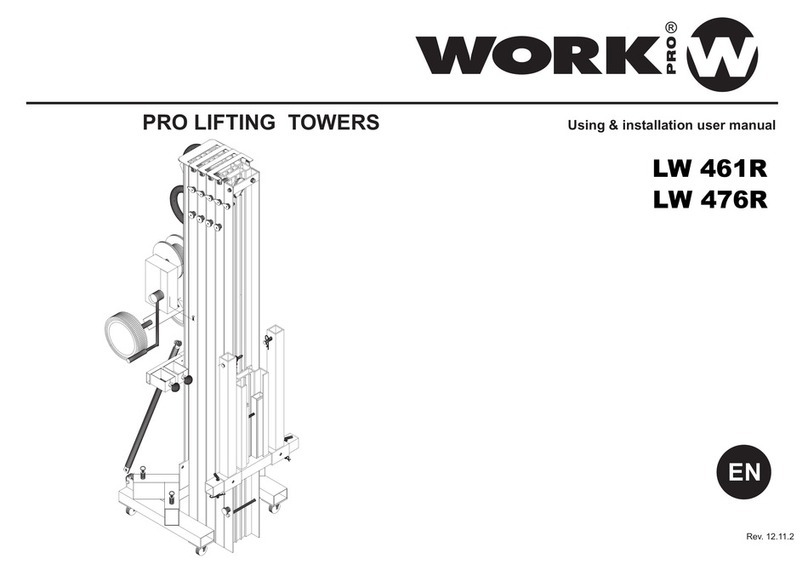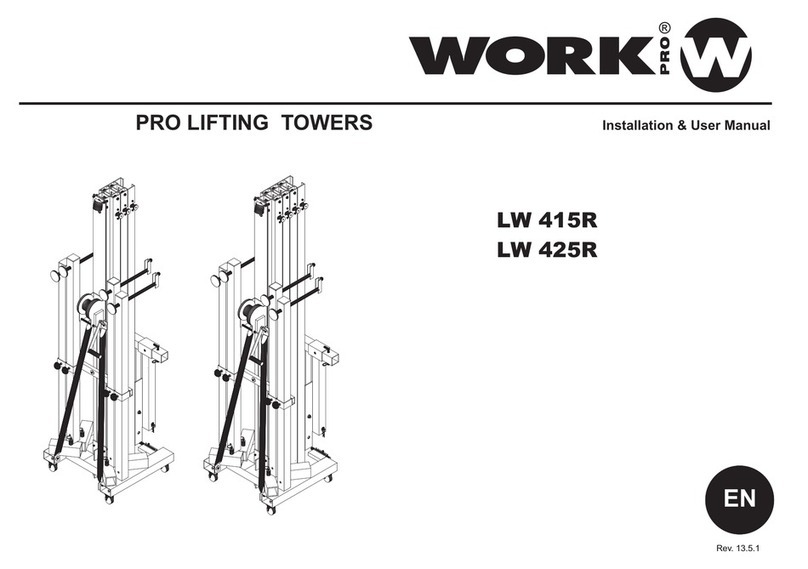
LW 465 R
LW 480 R
MAX MIN
LOAD LOAD
DISPLAYED TOWER FOLDED TOWER
(KG) (KG)
HEIGHT BASE HEIGHT BASE WEIGHT
(M) (M) (M) (M) (KG)
370 30 6,5 2,30 x 2,00 2,20 0,70 x 0,60
200
SPECIFICATIONS
220
WT 600 350 30 6,5 2,00 x 1,85 2,20 0,80 x 0,60 205
320 30 8,0 2,30 x 2,00 2,20 0,70 x 0,60
7
CROSSED
TO
RIGHT
DIN 15020 / VGB 1 / VGB 8
CABLE WINCH
COMPOS. Ø RESIST. LOAD WEIGHT/Mt ROLL.
(mm) (N / mm2) (KN - KP) (KG/M)
6 x 19+1
REDUCT.
RANGE
BOBBING
(m.)
30 10.5 : 1
26.7 - 2710 0,170
DIN 15020 / VGB 1 / VGB 8
DIN 15020 / VGB 1 / VGB 8
STANDARDS AND REGULATIONS
MODEL
Standards and Regulations applied on winches
incorporated on each lifting tower.
1770
(GALVANIZED)
FASTENER SYSTEM
This system uses a profiles specially designed in order to bear
heavy loads.The wide of these profiles and the thickness of their
walls ensures a big firmness of the set. These profiles incorporate
a rail with a serie of fixation holes where the security bolt are
located.
These holes have the sufficient size in order the bolts could be
introduced quickly, providing the folding speed of the tower.
The security bolts have been
oversized as much as piston
The block/unblock
a light pull and
make these operations easily and
with security.
diameter as main fixation piece.
system through
turning it allows to
above all
The pulley system (upper and lower on each profile) entrusts to transmit the generated strain
in the winch and to elevate the profiles, for this reason, these pulleys disposes of an appropiate
design in order to handle the cable, enclosing the whole system in a compact set.
LW 465R/480R/WT 600 LIFTING TOWERS
INSTALLATION AND USER MANUAL 3
LW 465 R
LW 480 R
WT 600
LW 465 R
LW 480 R
WT 600
CAPACITY
The profiles have been designed with a
cylindrical reinforcement along then which
arise de strength of the whole tower.
FROM THE
WINCH
TO THE NEXT
PROFILE
PROFILE 1 PROFILE 2
The fastener system operates in following way:
We turn clockwise the winch that thighten the cable and thanks
to the pulley system, the more outer profile is elevated.
ALL SECURITY BOLTS MUST BE IN BLOCK POSITION,
so the elevation of the profile cause that the spring pin
of the bolt retracts, which triggers when a hole of the profile
is located in paralell with it, blocking the tower in that position.
LOAD
FASTENER SYSTEM (explanation)
PROFILE
(section view)
BOLT LOCATED
IN A BLOCK
POSITION
SPECIFICATIONS
This situation is not 100% assured. The load could deploy an
intermediate section but the lifting process will restore the normal
unfolding.
For the descent, we must to unblock the lower security bolt and turn the winch on inverse
sense, the load bring down the profile up to the stand position, in that moment we must
to block the bolt for the transport use and we must unblock the new security bolt from
the descended profile.
We proceed in the same way, with all profiles up to the total tower unfolding.
In this point, there is a strain in the cable in order
to keep unfolded the pulley system, but all load is
supported by the security bolts, releasing the winch
and give up using it.
We continue elevating the tower up to the security
bolt locates in the las hole of the elevated profile.
In that moment, the next profile is elevated
identically up to total tower folding.
LW 465R/480R/WT 600 LIFTING TOWERS
INSTALLATION AND USER MANUAL 4





























